Similar presentations:
The relationship between EU law and national legal systems
1. The relationship between EU law and national legal systems
THE RELATIONSHIP BETWEEN EU LAWAND NATIONAL LEGAL SYSTEMS
2. Main questions
MAIN QUESTIONSWhich source of law will take precedence in case of
conflict between EU law and national law?
What will the effect of EU law in the Member States be?
Who receives rights and obligations under EU law?
Where and how may such rights be enforced?
2
3. Original situation (The treaties)
ORIGINAL SITUATION (THE TREATIES)The founding Treaties did not directly address these questions.
The Member States originally assumed that EEC law would have the same
domestic effects as other sources of international law.
So, the status of the EEC Treaty was determined by each Member State’s
own constitutional rules.
3
4. Original situation (The treaties) (2)
ORIGINAL SITUATION (THE TREATIES) (2)In dualist States (such as the UK), international law is only binding on
individuals if it has been adopted by the national authorities and made
part of domestic law.
In dualist States, it was considered that the EEC Treaty would bind the state
but not provide enforceable rights to individuals unless specifically
incorporated.
4
5. Role of THE European Court of Justice
ROLE OF THE EUROPEAN COURT OF JUSTICEIn monist States (such as NL, FR), once ratified, international law
automatically forms part of the national legal system.
In monist States, it was assumed that EEC law automatically became part
of that State’s domestic legal system.
So, the status – and impact – of EEC law varied from State to State.
The ECJ, however, took a different approach and developed two
fundamental principles:
1.
direct effect
2.
supremacy.
5
6.
67. The doctrine of supremacy of Union law
THE DOCTRINE OF SUPREMACY OFUNION LAW
7
8. The creation of the doctrine of supremacy
THE CREATION OF THE DOCTRINE OF SUPREMACYWhile the Court did not address the issue of supremacy of EU law directly
in Case 26/62, Van Gend en Loos (Van Gend), it explained that Union (then
Community) law constitutes a ‘new legal order . . . for the benefit of which
the States have limited their sovereign rights, albeit within limited fields’.
(The Court’s judgment resulted in Union law (what is now Art 34 TFEU)
being applied, rather than the conflicting national (Dutch) law, which was
set aside by the domestic court.)
The Court clearly recognized that to allow Member States to apply
conflicting national law rather than Union law would severely undermine
the ability of the EU to achieve its aims.
Thus, the doctrine of the supremacy (or primacy) of Union law was
established.
8
9. The development of the doctrine of supremacy
THE DEVELOPMENT OF THE DOCTRINE OFSUPREMACY
The implications of the doctrine of supremacy were not fully addressed
until Case 6/64, Costa v ENEL.
In this judgment the Court confirmed that where national law and EU law
conflict, EU law must take precedence, even where the national law has
been enacted subsequent to EU law;
this ruled out the possibility of national law taking precedence under the
concept of ‘implied repeal’ (i.e. a constitutional principle under which
legislation is presumed to have been repealed by later, conflicting,
legislation).
9
10. The development of the doctrine of supremacy (2)
THE DEVELOPMENT OF THE DOCTRINE OFSUPREMACY (2)
The Court provided a number of arguments in support of its dicta.
First, it confirmed that EU law is an integral part of domestic legal systems,
and that Member States had created this new legal system by limiting their
sovereign rights and transferring power to the EU.
Drawing heavily on the spirit and aims of the (then EEC) Treaty, the Court
pointed out that the uniformity and effectiveness of Union law would be
jeopardized should national law be allowed to take precedence.
10
11. The development of the doctrine of supremacy (3)
THE DEVELOPMENT OF THE DOCTRINE OFSUPREMACY (3)
In addition, the Court argued that the obligations undertaken by the
Member States would be ‘merely contingent’ rather than ‘unconditional’ if
they could ‘be called into question by subsequent [national] legal acts’.
The Court also referred directly to the text of the EEC Treaty to support its
judgment.
Although the original Treaties did not – and the TEU and TFEU still do not –
provide directly for the supremacy of European law, the Court of Justice
has argued that Art 288 TFEU, which provides for the direct applicability of
regulations, would be meaningless if Member States could negate their
effect by enacting subsequent, conflicting legislation.
11
12. The development of the doctrine of supremacy (4)
THE DEVELOPMENT OF THE DOCTRINE OFSUPREMACY (4)
While Van Gend and Costa dealt with the theoretical principle of
supremacy, the Court had little to say on the practical application of the
concept.
A serious threat to the supremacy of EU law was revealed in Case 11/70,
Internationale Handelsgesellschaft (IHG), when the German Administrative
Court voiced its concern over the legal foundations on which the principle
of supremacy was based.
The German Court was concerned that fundamental rights contained
within the German constitution could be overruled by European law.
12
13. The development of the doctrine of supremacy (5)
THE DEVELOPMENT OF THE DOCTRINE OFSUPREMACY (5)
The ECJ made it clear that EU law is supreme over all forms and sources of
national law
at the same time it declared that the Union recognized such fundamental
rights as an ‘integral part of the general principles of law’ whose protection
would be ensured ‘within the structure and objectives of the Community’
(now Union).
13
14. The development of the doctrine of supremacy (6)
THE DEVELOPMENT OF THE DOCTRINE OFSUPREMACY (6)
In Case 106/77, Amministrazione delle Finanze dello Stato v Simmenthal, as
a result of a preliminary reference, the ECJ was required to consider
whether a national court should dis-apply conflicting national legislation,
even in situations where that court had no domestic jurisdiction to do so
(in Italy, this function was only to be carried out by the Constitutional
Court).
The Court provided that where conflict arises between national and
European law, the national court is required to give immediate effect to EU
law and not wait for a ruling from the Constitutional Court.
14
15. The development of the doctrine of supremacy (7)
THE DEVELOPMENT OF THE DOCTRINE OFSUPREMACY (7)
This judgment is important, in that it confers on all domestic courts’
jurisdiction that they may not have under domestic law.
Once more, the European Court emphasized the need for such action in
order to ensure the effectiveness of Union law.
15
16. The development of the doctrine of supremacy (8)
THE DEVELOPMENT OF THE DOCTRINE OFSUPREMACY (8)
A further example of the jurisdiction of national courts being extended by
Union law can be found in Case C-213/89, R v Secretary of State for
Transport ex p Factortame Ltd (Factortame (No 2)).
In this case, the ECJ explained that a national rule must be set aside by a
national court if that rule interferes with an EU law right.
This can be seen as an additional example of the practical consequences of
the doctrine of supremacy.
16
17.
1718. The doctrine of direct effect of EU Law
THE DOCTRINE OFDIRECT EFFECT OF EU LAW
18
19. The creation of the doctrine of direct effect
THE CREATION OF THE DOCTRINE OFDIRECT EFFECT
The ECJ provided a ground-breaking judgment in Case 26/62, Van Gend en
Loos (Van Gend).
Van Gend imported goods from Germany into the Netherlands.
He was required, by Dutch law, to pay customs duty on the goods to the
Dutch authorities.
The importers challenged the legality of the duty, claiming that it was an
infringement of what is now Art 30 TFEU.
The Dutch tribunal referred the question to the ECJ under the preliminary
reference procedure (Art 267 TFEU).
19
20. The creation of the doctrine of direct effect (2)
THE CREATION OF THE DOCTRINE OFDIRECT EFFECT (2)
In order to arrive at its decision, the Court of Justice drew heavily on its
purposive method of interpretation, relying not only on the wording of the
Treaty, but also on the spirit and aims of the Union (then, Community).
In its judgment, the Court declared that the Union constituted a new legal
order of international law, which conferred both rights and obligations on
individuals, as well as on the participating Member States, without the
need for implementing legislation.
The Court further concluded that national courts must protect such rights.
20
21. The creation of the doctrine of direct effect (3)
THE CREATION OF THE DOCTRINE OFDIRECT EFFECT (3)
In other words, the Court of Justice provided that EEC law (now EU law) had direct
effect, which can be seen as a two-pronged concept under which:
a)
EU law provides individuals, as well as Member States, with rights and
obligations; and
b)
such rights and obligations are enforceable by national courts.
From this judgment, which was opposed by a number of Member States, it can be
concluded that the Court was motivated by the need to ensure the integration,
effectiveness and uniformity of EU law.
21
22. The conditions for direct effect (Van Gend criteria)
THE CONDITIONS FOR DIRECT EFFECT(VAN GEND CRITERIA)
The Court explained in Van Gend that not all Treaty articles would be
capable of direct effect.
It is now clear that any provision must first fulfill a set of criteria if it is to
be directly effective (the Van Gend criteria, also called the Reyners criteria).
The Van Gend criteria require that in order to have direct effect, the legal
provision must be:
22
23. Van Gend criterion n. 1
VAN GEND CRITERION N. 1clear and precise
it is logical that if law is to be enforceable, both parties must be clear as to
what their respective rights/obligations are. The ECJ has therefore declared
that a provision must be ‘sufficiently clear and precise’ before being
capable of direct effect.
This does not necessarily mean that the whole provision must comply: for
example in Case 43/75, Defrenne v Sabena, it was held that only part of Art
119 EEC (now Art 157 TFEU) fulfilled this criterion but that part was still
held to have direct effect;
23
24. Van Gend criterion n. 2
VAN GEND CRITERION N. 2unconditional
a provision will not be unconditional if the right it provides is in some way
dependent on the judgment or discretion of an independent body unless
that discretion is subject to judicial control (an example of this may be
found in Case 41/74, Van Duyn);
24
25. Van Gend criterion n. 3
VAN GEND CRITERION N. 3not subject to any further implementing measures on
the part of either the Union or national authority
this criterion would appear to have been subject to a liberal application by the
Court, as can be demonstrated in Case 2/74, Reyners.
In this case, based on the wording of the Treaty, it had been anticipated that
secondary legislation would have to be enacted before the objectives contained in
Art 52 EEC (now Art 49 TFEU) would provide rights to individuals.
However, the Court declared the provision to be directly effective, explaining that
to do otherwise could result in individuals being denied their EU law rights.
25
26.
2627. Direct effect of different sources of Union law
DIRECT EFFECT OFDIFFERENT SOURCES OF UNION LAW
27
28. Direct effect and Treaty articles
DIRECT EFFECT AND TREATY ARTICLESThe question of whether the principle of direct effect applies to Treaty
articles was considered in the judgment of Van Gend en Loos and it is now
well accepted that all Treaty articles that comply with the Van Gend criteria
are capable of direct effect.
In addition, the Court has provided that rights and obligations contained in
Treaty articles may be enforced both against the State and public bodies
(known as vertical direct effect: Van Gend) and against private bodies and
individuals (known as horizontal direct effect: Case 43/75, Defrenne v
Sabena).
28
29. Direct effect and regulations
DIRECT EFFECT AND REGULATIONSArticle 288 TFEU would appear to give regulations direct effect.
The Article states that a regulation ‘shall be binding in its entirety and
directly applicable in all Member States’.
(Direct applicability, which should not be confused with direct effect, has
been interpreted as meaning that a provision requires no implementation
or further action by the States in order for it to take effect in national law.)
While all regulations are directly applicable (as are Treaty articles), the
Court confirmed in Case 9/70, Franz Grad, that regulations would only be
directly effective when they fulfill the Van Gend criteria.
As with Treaty articles, regulations may be enforced both vertically and
horizontally.
29
30. Direct effect and decisions
DIRECT EFFECT AND DECISIONSDecisions, as regulations, are directly applicable, but Art 288 TFEU provides
that they can be binding on those to whom they are addressed (whether
that be Member States, corporations or individuals).
The Court of Justice has held that decisions will be directly effective,
providing they fulfill the Van Gend criteria, against an addressee (Case
9/70, Franz Grad).
30
31. Direct effect of international agreements
DIRECT EFFECT OF INTERNATIONAL AGREEMENTSIn an attempt to ensure that Member States respect any commitments
arising from such agreements, the Court has ruled that international
agreements (such as free trade agreements) may have direct effect if the
circumstances are appropriate (Case 104/81, Kupferberg, Art 216 TFEU).
31
32. Direct effect and directives
DIRECT EFFECT AND DIRECTIVESThis is a particularly controversial area.
Article 288 TFEU provides that: ‘A directive shall be binding, as to the result
to be achieved, upon each Member State to which it is addressed, but shall
leave to the national authorities the choice of form and methods.’
Directives are therefore not directly applicable, as they require
implementation into national law by each State’s legislative body.
So, directives do not provide rights to individuals until they have been
incorporated through national legislation, rather than through the directive
itself;
although they do place obligations on Member States.
32
33. Direct effect and directives (2)
DIRECT EFFECT AND DIRECTIVES (2)The wording of Art 288 TFEU seems to preclude directives from being
directly effective;
Still, the ECJ has held that where a directive has not been properly
implemented into national law, it may still give rise to direct effects (Franz
Grad and Van Duyn).
The Court has confirmed that in order for directives to be directly effective,
they must satisfy the Van Gend criteria.
While the first two criteria present few problems, it would appear that the
final criterion is impossible to satisfy. However, once the date on which the
directive should have been implemented has passed, the ECJ has shown
itself willing to conclude that this criterion has also been satisfied (Case
148/78, Pubblico Ministero v Ratti).
33
34. Direct effect and directives (3)
DIRECT EFFECT AND DIRECTIVES (3)The Court has argued that this approach results in directives being more
effective;
it also stops Member States from relying on their own ‘wrongdoing’ should
they fail to incorporate a directive into domestic law.
This development, however, has been criticized by some who argue that to
allow directives direct effect removes the intended distinction between
regulations and directives.
34
35. Direct effect and directives (4)
DIRECT EFFECT AND DIRECTIVES (4)In response to such criticism, the ECJ has explained that directives are
distinct as they may only be enforced vertically (that is, against the State)
and not horizontally (that is, against individuals) (Case 152/84, Marshall v
Southampton and South West Hampshire AHA (Marshall (No 1)).
In the Marshall case, Miss Marshall wished to enforce rights emanating
from the Equal Treatment Directive (Council Directive (76/207/EEC)),
against her employer.
She attempted to do this in the appropriate national court, i.e. an
employment tribunal (ET).
35
36. Direct effect and directives (5)
DIRECT EFFECT AND DIRECTIVES (5)The ET made a preliminary reference to the ECJ (under Art 267 TFEU),
asking whether Ms Marshall could rely on the Directive.
The Court replied that she could, as her employers were a public body and
therefore part of the State – in other words, she could rely on the vertical
direct effect of the Directive.)
36
37. Direct effect and directives (6)
DIRECT EFFECT AND DIRECTIVES (6)This requirement has the unfortunate effect of discriminating between
individuals who wish to enforce their rights against a State or public body,
as compared to those wishing to pursue the same rights against a private
body.
The problem can be illustrated by consideration of Case 151/84, Roberts v
Tate & Lyle Industries (the Tate & Lyle case), which mirrored the
circumstances of Marshall (No 1).
Ms Roberts also wished to enforce rights emanating from the Equal
Treatment Directive but she was employed by a private corporation as
opposed to an emanation of the State, so her rights were unenforceable.
37
38. Developing the effectiveness of directives
DEVELOPING THE EFFECTIVENESSOF DIRECTIVES
38
39. Vertical direct effect: a wide interpretation of ‘State’
VERTICAL DIRECT EFFECT:A WIDE INTERPRETATION OF ‘STATE’
To address the problem highlighted above, the ECJ has shown itself willing
to adopt the widest possible definition of ‘State’.
The Court has been willing to recognize a Health Authority as part of the
State (in Marshall No 1);
in Case 103/88, Fratelli Constanzo, regional and local government were
also considered to be within the definition.
In Case 222/84, Johnston v Chief Constable of the RUC, the Chief Constable
was also recognized as an ‘emanation of the State’.
39
40. Vertical direct effect: a wide interpretation of ‘State’ (2)
VERTICAL DIRECT EFFECT:A WIDE INTERPRETATION OF ‘STATE’ (2)
In Case C-188/89, Foster v British Gas, the Court of Justice provided some
guidance (note: these are not criteria) on what could be considered an
‘emanation’:
a directive may be relied upon against organizations or bodies which:
a)
have been made responsible for providing a public service; and/or
b)
are subject to the authority or control of the State; and/or
c)
have special powers beyond those which result from the normal rules
applicable to relations between individuals.
These guidelines (not criteria), fail to provide an inclusive definition of ‘State’,
but have nevertheless proved helpful by making it clear that something more
than mere control is necessary.
40
41. Vertical direct effect: a wide interpretation of ‘State’ (3)
VERTICAL DIRECT EFFECT:A WIDE INTERPRETATION OF ‘STATE’ (3)
This conclusion is supported by the Court of Appeal’s dicta in Doughty v
Rolls Royce (1992).
Although Rolls Royce was, at the time of the action, wholly owned by the
British State, it was not considered an ‘emanation of the State’ as the
company neither provided a public service nor had any of the ‘special
powers’ referred to in Foster.
Note that it is for the national courts to decide whether a defendant is an
emanation of the state or not.
41
42. Indirect effect or the ‘interpretive obligation’
INDIRECT EFFECTOR THE ‘INTERPRETIVE OBLIGATION’
42
43. Indirect effect
INDIRECT EFFECTThe ECJ’s refusal to allow the horizontal direct effect of directives has
without doubt lessened their effectiveness as legislative instruments.
In an attempt at remedying this, the Court has developed a principle which
has become known as ‘indirect effect’ or ‘the interpretative obligation’.
43
44. The basic principle of Indirect effect
THE BASIC PRINCIPLE OF INDIRECT EFFECTIn Case 14/83, Von Colson, the Court reminded Member States of their
duty, provided under Art 10 TEC (now Art 4 TFEU), to ‘take all appropriate
measures . . . to ensure the fulfilment of the obligations arising out of this
Treaty’ and also to ‘facilitate the achievement of the Community’s tasks’.
The Court explained that such obligations also bind all the authorities of
the States including, for matters within their jurisdiction, the national
courts.
Consequently, an obligation is placed on national courts to interpret and
apply national law in a manner which is consistent with the wording and
purpose of directives.
44
45. The basic principle of Indirect effect (2)
THE BASIC PRINCIPLE OF INDIRECT EFFECT (2)This judgment has been the subject of much academic criticism as, it is
argued, it requires national courts to supplement the role of the domestic
legislator.
The principle has also been criticized for allowing the direct effect of
directives via the ‘back door’, without the need to ensure that the
restrictive Van Gend criteria are fulfilled.
The principle has, however, undoubtedly succeeded in:
enhancing the effectiveness of unimplemented and/or incorrectly
implemented directives;
penalizing Member States who fail to comply with their obligations.
45
46. The development of the doctrine of indirect effect
THE DEVELOPMENT OF THE DOCTRINE OFINDIRECT EFFECT
The Von Colson judgment left a number of questions unanswered with
regard to the exact extent of the principle of ‘indirect effect’.
In Case 80/86, Kolpinghuis Nijmegen, the Court made it clear that it would
not be possible to interpret national legislation in the light of a directive
should this result in conflict with any of the general principles of Union law,
such as non-retroactivity or legitimate expectation.
Thus, there are limits on the application of indirect effect, and national
courts need only interpret national law to conform with directives ‘in so far
as it is possible’.
46
47. The development of the doctrine of indirect effect (2)
THE DEVELOPMENT OF THE DOCTRINE OFINDIRECT EFFECT (2)
In Case C-106/89, Marleasing, the ECJ confirmed that national legislation,
which has been interpreted by a national court in the light of a nonimplemented or incorrectly implemented directive, can be relied on, not
only by an individual against a State, but also against another individual
and even where such national law pre-dates a directive and was not
intended to implement it.
This would appear to be allowing unincorporated directives to be enforced
against individuals, thus achieving ‘horizontal direct effect’ in all but name.
47
48. The development of the doctrine of indirect effect (3)
THE DEVELOPMENT OF THE DOCTRINE OFINDIRECT EFFECT (3)
However, the decision in Marleasing has been tempered in Case C-456/98,
Centrosteel, where the ECJ provided that a directive cannot of itself impose
criminal liability on individuals in the absence of proper implementing
legislation.
Further, the Court has confirmed that the interpretive duty only arises
once the date for implementation has passed (Case C-212/04, Adeneler
and Others).
48
49. The development of the doctrine of indirect effect (4)
THE DEVELOPMENT OF THE DOCTRINE OFINDIRECT EFFECT (4)
Academics have highlighted that indirect effect is the most used means of
ensuring proper effect of incorrectly or unimplemented directives and its
importance should not, consequently, be underestimated.
The Court has regularly reaffirmed its importance and, in joined Cases C397–403/01, Pfeiffer and Others (a case relating to the ‘Working Time
Directive’), provided that ‘the requirement for national law to be
interpreted in conformity with Community law is inherent in the system of
the Treaty . . . to ensure the full effectiveness of Community law . . .’.
49
50. ‘Incidental’ or ‘triangular’ effect
‘INCIDENTAL’ OR ‘TRIANGULAR’ EFFECTDespite the Court of Justice’s decision in Marshall (No 1) prohibiting the
horizontal direct effect of directives, in Case C-194/94, CIA Security
International the Court appeared to allow the equivalent of horizontal
effect to directives, albeit in limited manner.
It would seem that where an individual attempts to demonstrate that
national law conflicts with a directive, and such illegality is proven, the
Court has signaled that EU law (i.e. the directive) must be applied – even
where this has an impact on a third party, providing that no legal
obligations are imposed directly on the individual(s) as a result.
50
51. ‘Incidental’ or ‘triangular’ effect (2)
‘INCIDENTAL’ OR ‘TRIANGULAR’ EFFECT (2)Once more, the ECJ cited the enhanced effectiveness of directives as its
aim in allowing this.
Other cases in which this principle has been utilized include Case C-443/98,
Unilever Italia and Case C-201/02, Wells.
However, due to its limitations, it should be noted that the ‘incidental
effect’ of directives is likely to arise only in very limited circumstances.
51
52. Additional thoughts on the source of an EU right or obligation
ADDITIONAL THOUGHTS ON THE SOURCE OF ANEU RIGHT OR OBLIGATION
While the matter of the relevant source of a right or obligation (that is,
whether the right in question emanates from a treaty article or regulation,
for example) is rarely problematic, Case C-144/04, Mangold is worth taking
a moment to consider.
In this case it appeared that the source of the claimant’s right was a
Directive, the expiry date of which had not yet passed.
Consequently, the Directive could not have direct effect but, as the right in
question related to a matter of discrimination, the Court of Justice
provided that the right could emanate from the General Principle of Nondiscrimination, as opposed to the Directive in question.
52
53. State liability for damages (the Francovich principle)
STATE LIABILITY FOR DAMAGES(THE FRANCOVICH PRINCIPLE)
53
54.
In view of the limitations placed on the direct effect of directives, and
despite
the possibility of enforcing rights under the principle of indirect effect, a
number of barriers may still exist with regard to the enforcement of rights
emanating from a directive
(for example, there may be no national law to interpret or interpretation
may simply not be possible due to the wording of the national legislation
being very precise).
54
55.
In Cases C-6 and 9/90, Francovich and Bonifaci v Italy (Francovich), the Court of
Justice held that, should a Member State fail to incorporate a directive into
national law, an individual who suffers damage as a consequence may claim
compensation from that State, thereby ensuring greater effectiveness of
directives.
But this right to compensation was subject to several criteria:
a)
the directive must be intended to confer a right on citizens;
b)
the content of the right must be identifiable by reference to the directive;
c)
there must be a causal link between the State’s breach and the damage
suffered.
The Court’s judgment in Francovich reinforces Member States’ obligations under
Art 4 TEU and also provides a further incentive to Member States to ensure that
EU law rights are not denied to individuals.
55
56. The development of State damages
THE DEVELOPMENT OF STATE DAMAGESThe Francovich ruling has been of immense importance to Union law and
the principle has been clarified and extended in a number of later cases.
While in Francovich, the ECJ’s decision related to a Member State’s failure
to fulfill its obligations in relation to directives, in joined Cases C-46 and C48/93, Brasserie du Pêcheur SA v Germany; R v Secretary of State for
Transport ex p Factortame Ltd and Others (Pêcheur and Factortame), the
Court confirmed that damages could also be available in situations where a
Member State had failed to fulfill obligations derived from other sources of
Union law.
56
57.
Once more, however, the Court explained that certain criteria must be
fulfilled:
a)
the rule of law infringed must be intended to confer rights on individuals;
b)
the breach must be sufficiently serious;
c)
there must be a direct causal link between the States breach and the
damage caused.
The Court also provided that the principle applied to whichever State
organ was responsible for the breach or omission, legislative, executive or
judicial.
57
58. The Court of Justice’s interpretation of ‘sufficiently serious’
THE COURT OF JUSTICE’S INTERPRETATION OF‘SUFFICIENTLY SERIOUS’
With regard to what will constitute a ‘sufficiently serious’ breach, the Court has
put forward various factors that may be taken into account, including the
following:
a)
the degree of clarity and precision of the EU rule that has been breached (if the
rule is imprecisely worded, the breach will not be sufficiently serious: Case C392/93, R v HM Treasury ex p British Telecom);
b)
the ‘intentionality’ or ‘voluntariness’ of the infringement and the damage
caused (intentional fault is not essential: Cases T-178, 179 and 188–90/94,
Dillenkofer v Germany);
c)
the degree of discretion provided to the Member State by the provision (where
there is no, or limited, discretion, the infringement of law in itself may be
sufficient to establish the existence of a sufficiently serious breach: Case C-5/94,
R v MAFF ex p Hedley Lomas).
58
59. Expansion of the principle to actions against private parties
EXPANSION OF THE PRINCIPLE TO ACTIONSAGAINST PRIVATE PARTIES
In addition to the Francovich principle being expanded beyond non- or
ineffective implementation of directives to any sufficiently serious breach
of Union law by a Member State, it would now appear that such actions for
damages may also be available against private bodies.
This can be evidenced by Case C-453-/99, Courage Ltd v Crehan.
In this case an individual brought an action against another individual for
damage suffered as a result of a breach of EU competition law.
No national remedy was available for the breach;
So, the Court of Justice confirmed that an action may be brought under the
Francovich principle not just against Member States but against private
individuals/bodies that cause loss to another through breach of Union law.
59
60. TO RECAPITULATE:
6061. DIRECT EFFECT
Two-pronged principle providing:Developed by the Court of
Justice in Van Gend
• EU law creates rights and obligations for
both MSs and individuals
• Such rights and obligations may be
enforced before NATIONAL courts
Effects of principle:
The principle
of direct effect
• Increases effectiveness of EU law
• Provides uniformity of EU law in all MSs
• Supports integration
61
62. DIRECT EFFECT of Union Law
DIRECT EFFECT OF UNION LAW(Note: EU law also enjoys SUPREMACY)
What is the source of the EU right?
a)
Treaty Article or Regulation: Enforceable before national court IF source
satisfies the 3 Van Gend/Reyners criteria (if not, right may not be enforceable
through direct effect). Capable of vertical and horizontal d/effect (Defrenne)
b)
Decision: Enforceable against addressee only IF 3 Van Gend/Reyners criteria
satisfied (if not, right may not be enforceable)
c)
Directive: More problematic. Enforceable only IF 3 Van Gend/Reyners criteria
are satisfied. Implementation date also must have passed (Ratti). Only
enforceable vertically against a State (Marshall). Note the broad interpretation
of ‘State’ (guidance on what may be an emanation of the State provided in
Foster v British Gas)
62
63. ALTERNATIVES TO DIRECT EFFECT
Where direct effect is not available, consider:
a)
Indirect effect (interpretive obligation): National law may be interpreted
in light of an unincorporated directive once date for implementation has
passed (Von Colson) in so far as it is possible to do so (Marleasing).
b)
Incidental direct effect: Directive may be given effect where national law
and directive conflict and national law is disapplied, thereby giving rights,
under the directive, to an individual (CIA and Unilever). Only available in
exceptional circumstances.
c)
State damages: Available where an individual has suffered loss as a result
of MS breach (failure to incorporate directive or other sufficiently serious
breach: Francovich, Pêcheur and Factortame). Criteria must be satisfied.
63














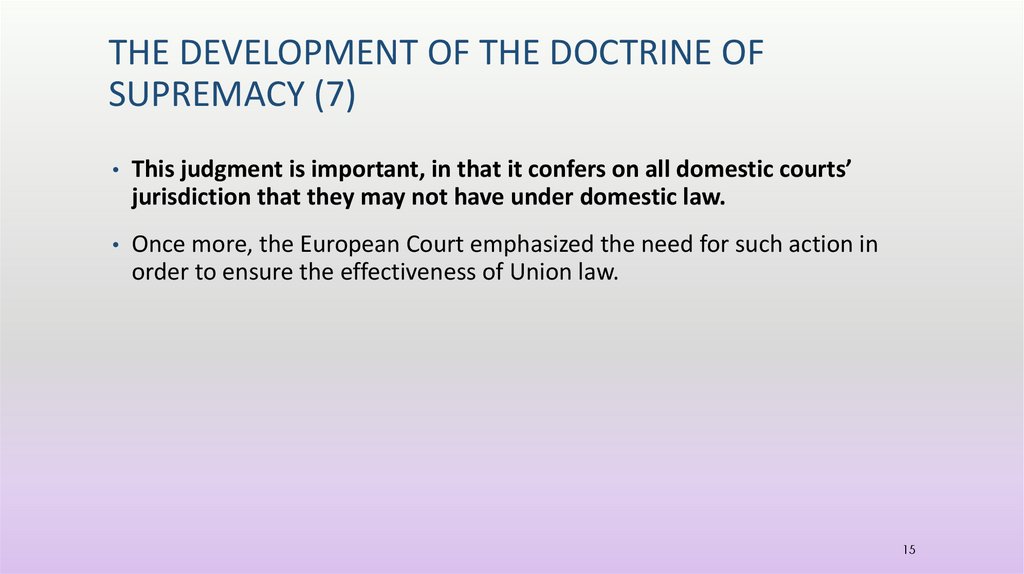




















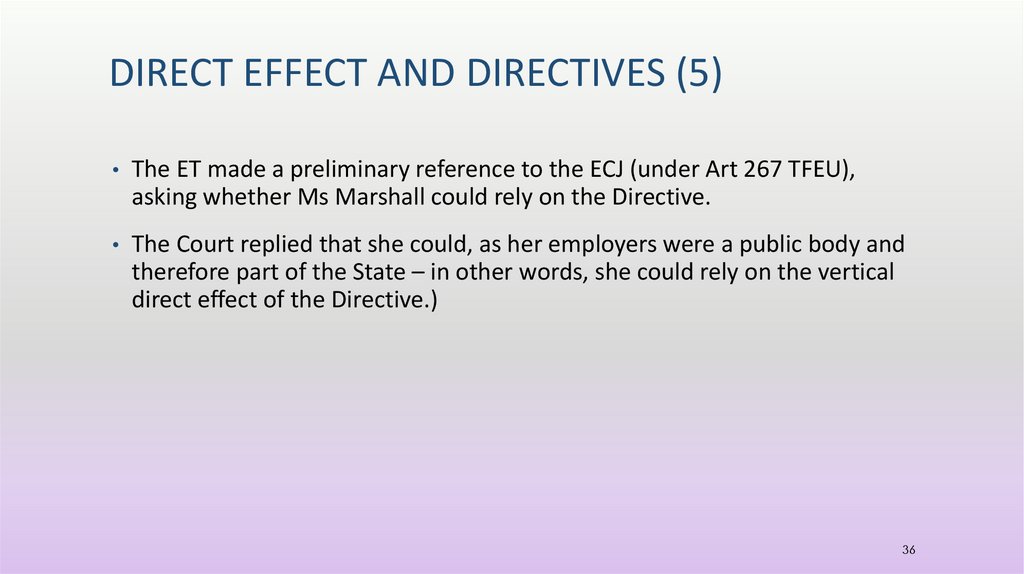














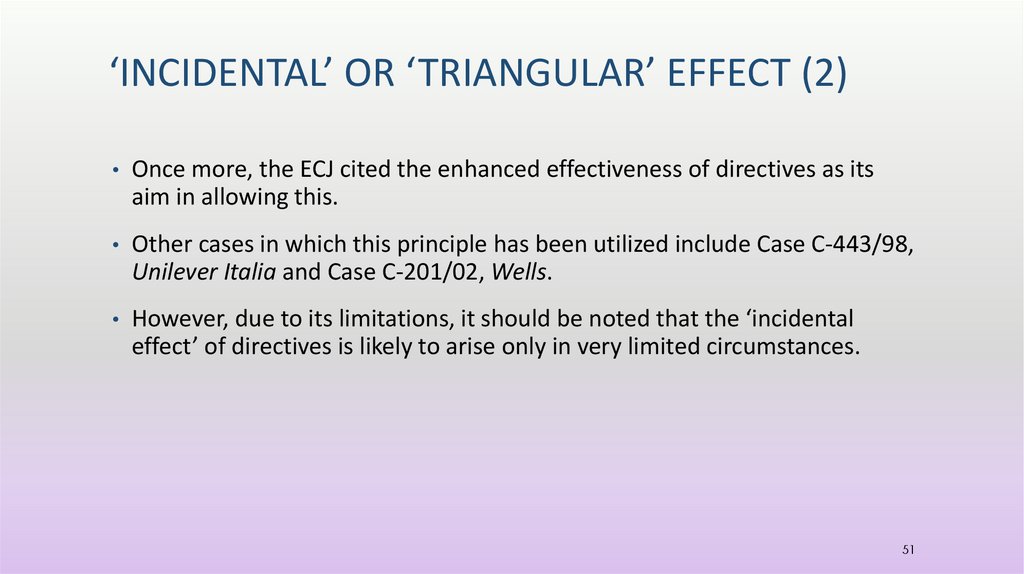
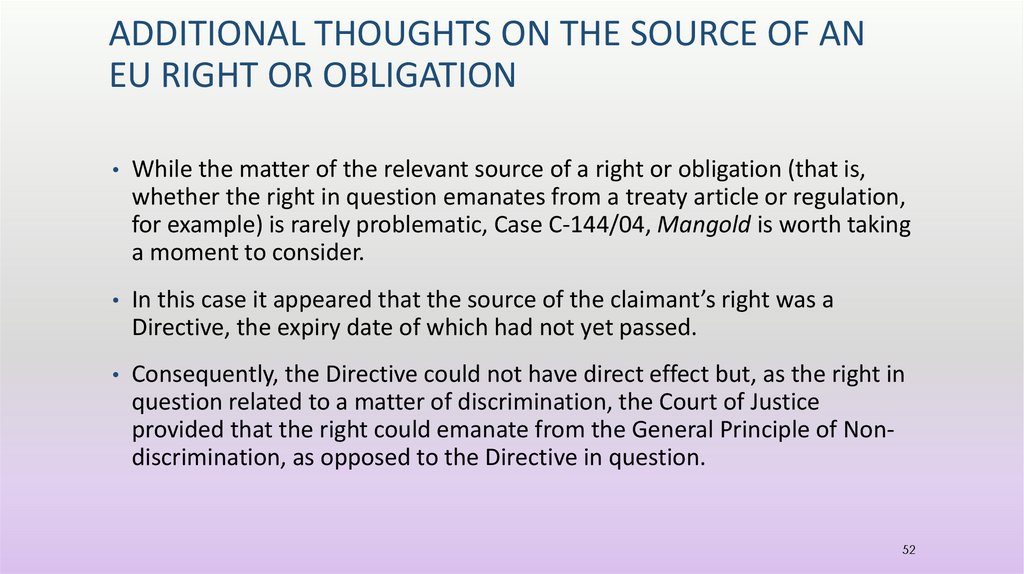








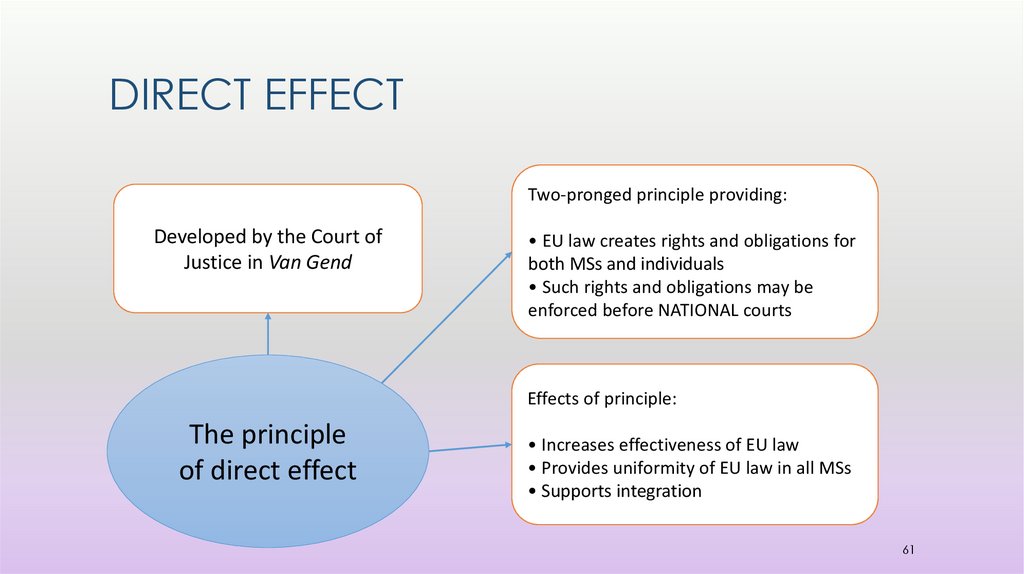
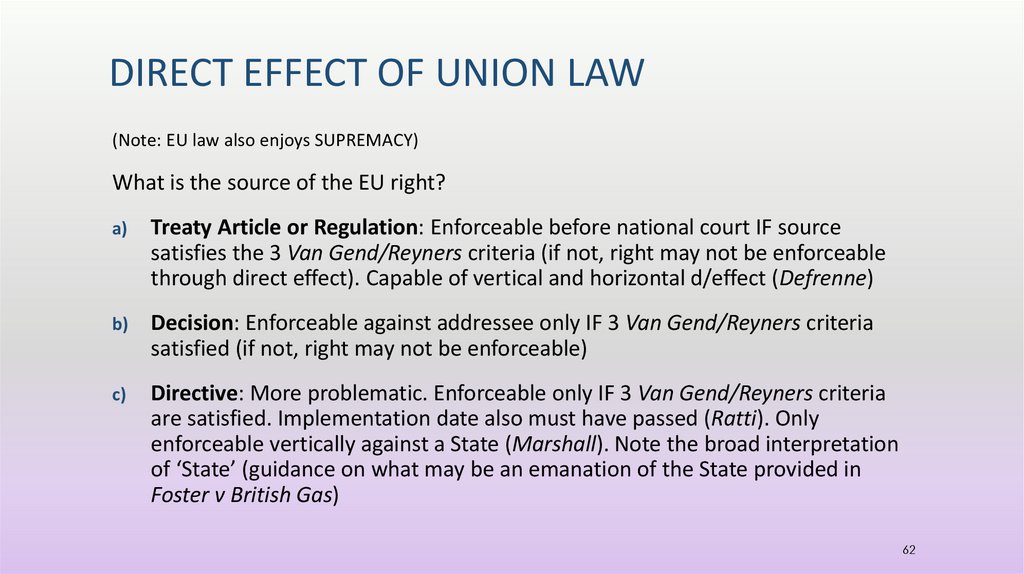


 law
law








